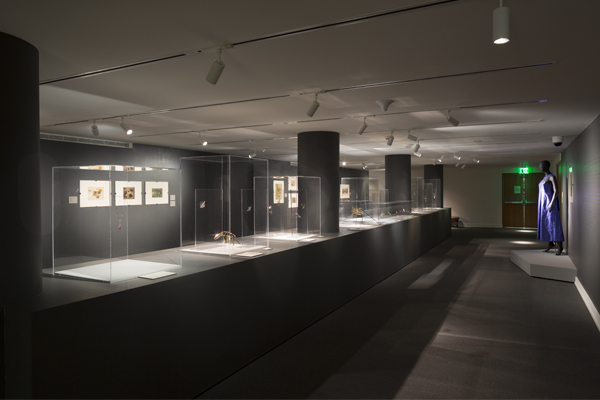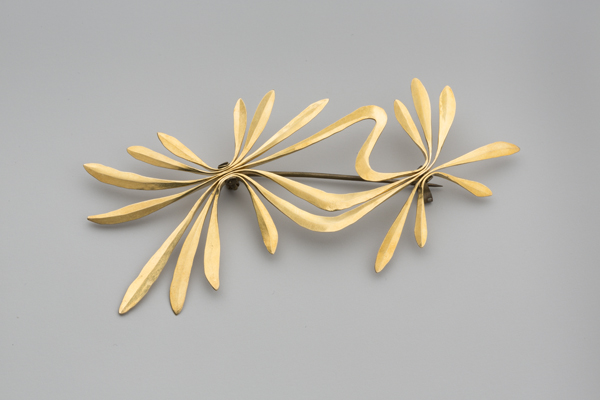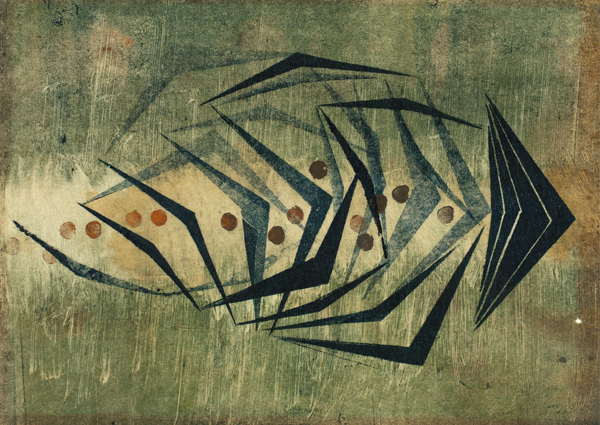March 24–November 29, 2015
Cranbrook Art Museum, Bloomfield Hills, Michigan, USA
For those interested in the history of 20th-century design, the name Harry Bertoia should be a familiar one. Bertoia’s humble beginnings as a 15-year-old Italian immigrant were soon eclipsed by his ambitious and prodigious work as an art student, metalsmith, and eventually educator at a succession of Detroit-based art institutions in the years bracketing World War II.[1] While Bertoia’s mature career focused on designing for industry and creating sculpture, his jewelry work—made almost exclusively during his early career, 1935–1950—was canonized by Toni Greenbaum in her 1996 book Messengers of Modernism: American Studio Jewelry 1940–1960.
 It is those early years that are the focus of Bent, Cast & Forged: The Jewelry of Harry Bertoia, the first exhibition devoted to Bertoia’s jewelry. Cranbrook Art Museum collections fellow Shelley Selim has assembled 31 pieces of jewelry, spanning Bertoia’s career from his earliest and most tightly controlled technical work as a student at the Detroit Society of Arts and Crafts to his later aural works made in the 1960s. Following exhibition design strategies established by the Victoria and Albert Museum, the Musée des Arts Décoratifs, and The Metropolitan Museum of Art, Bent, Cast & Forged is presented in a quiet, contemplative, and dimly lit basement gallery at the Cranbrook Art Museum with narrowly focused pin spotlights that draw attention to the lustrous metal objects on display. It is clear from the selection of works that Bertoia’s jewelry was a vehicle for the exploration of form and line in space. Yet, the exhibition features several works, particularly those lent from the collections of Kim and Al Eiber and the Philadelphia Museum of Art, which seem to transcend quick gestural studies of abstracted organic forms. These standout pieces are elegantly resolved compositions that combine the artist’s interest in the élan vital (vital impulse) of European abstract expressionism with his constructivist and modernist design explorations. No doubt this alloy was amalgamated in the crucible of the Cranbrook Academy of Art in the late 1930s and 40s alongside Charles Eames, Ray (Kaiser) Eames, Eero Saarinen, and other notable figures from the same remarkable period at the Academy.
It is those early years that are the focus of Bent, Cast & Forged: The Jewelry of Harry Bertoia, the first exhibition devoted to Bertoia’s jewelry. Cranbrook Art Museum collections fellow Shelley Selim has assembled 31 pieces of jewelry, spanning Bertoia’s career from his earliest and most tightly controlled technical work as a student at the Detroit Society of Arts and Crafts to his later aural works made in the 1960s. Following exhibition design strategies established by the Victoria and Albert Museum, the Musée des Arts Décoratifs, and The Metropolitan Museum of Art, Bent, Cast & Forged is presented in a quiet, contemplative, and dimly lit basement gallery at the Cranbrook Art Museum with narrowly focused pin spotlights that draw attention to the lustrous metal objects on display. It is clear from the selection of works that Bertoia’s jewelry was a vehicle for the exploration of form and line in space. Yet, the exhibition features several works, particularly those lent from the collections of Kim and Al Eiber and the Philadelphia Museum of Art, which seem to transcend quick gestural studies of abstracted organic forms. These standout pieces are elegantly resolved compositions that combine the artist’s interest in the élan vital (vital impulse) of European abstract expressionism with his constructivist and modernist design explorations. No doubt this alloy was amalgamated in the crucible of the Cranbrook Academy of Art in the late 1930s and 40s alongside Charles Eames, Ray (Kaiser) Eames, Eero Saarinen, and other notable figures from the same remarkable period at the Academy.

The exhibition also includes 14 monoprints, nearly all from the 1940s, whose inclusion seems to allude to Bertoia’s prolific and varied output as an artist and designer. The prints, all in the museum’s collection and many given by Bertoia himself, were made during his residency at Cranbrook. They inform the jewelry made concurrently—if somewhat tangentially. While the prints help to show the fertile experiments of a highly creative and ambitious artist, they seem to negate the exhibition’s thesis that jewelry was paramount to the artist or else that it was as important as his other output. The jewelry in the exhibition could easily stand on its own, and the fact that it does not seems like an admission of its supplemental role in the career of a major figure in 20th-century design.

Bent, Cast & Forged ultimately presents a coherent picture of Bertoia’s engagement with the medium and is a worthwhile destination for those interested in Bertoia and his legacy. The brevity of the show does not make it a feast, but a tasty morsel. However, the well-designed 67-page color catalog accompanying the exhibition satisfies any lingering cravings. And when the two are combined with a walk on the Cranbrook grounds—where one can contemplate the historical significance of the work while being immersed in its place of creation—an afternoon trip to the suburbs of Detroit could be counted as well worth it.
[1] Shelley Selim, Bent, Cast & Forged: The Jewelry of Harry Bertoia (Bloomfield Hills, Michigan: Cranbrook Art Museum, 2015), 10–25.




